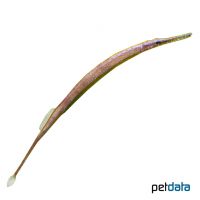Bellybar Pipefish (Hippichthys spicifer)
| Bellybar Pipefish Hippichthys spicifer | |
|---|---|
| Name | Bellybar Pipefish |
| Name Lat. | Hippichthys spicifer |
| Synonym | Syngnathus spicifer |
| Family | Pipefishes & Seahorses |
| Family lat. | Syngnathidae |
| Order | Pipefishes & Seahorses |
| Order lat. | Syngnathiformes |
| Origin | Asia, East Africa |
| Habitat | Estuaries, mangrove swamps |
| Diet | Carnivore |
| pH | 7.5-8.5 |
| Behavior | Peaceful |
| Keeping | Pair, group |
| Care Level | Difficult |
| Reproduction | ♂ brood pouch |
| Breeding | Difficult |
| Life Span | N/A |
| Protection | No |
| Metric Units | |
| Size | 16 cm |
| Temperature | 24-28 °C |
| Hardness | 16-24 °dH |
| Aquarium | ~ 200 l |
| US Units | |
| Size | 6" |
| Temperature | 75-82 °F |
| Hardness | 285-427 ppm |
| Aquarium | ~ 50 gal |
Distribution and habitat
The range of the brown pipefish extends from the coast of East Africa through India, Sri Lanka and Indonesia to the Philippines, Samoa and Tonga. There they live in the slow-flowing river bottoms and brackish estuaries, coastal lagoons and mangrove swamps among roots and dense underwater vegetation.
Maintenance
The aquarium should have a loose background and edge planting with tall plants (Vallisneria, etc.) and some roots (hiding places) and provide sufficient swimming space. A fine-grained substrate covered with some foliage (e.g. sea almond leaves) and medium to hard water is ideal
No ammonia, ammonium and nitrite should be detectable, the nitrate value should not exceed 100 mg/l. To ensure the water quality and oxygen content, a filter and heater adapted to the aquarium size is required, as well as lighting for the species-appropriate day-night rhythm of the animals.
Diet
In the wild they feed mainly on insect larvae and small crustaceans. The food supply consists of small live food, such as daphnia, mysis, artemia and black mosquito larvae, which is sometimes accepted in frozen form after habituation. Dry food (granules, pellets, flakes) is not accepted. They are very slow eaters and should be fed small portions several times a day. A regular and varied diet promotes health and increases resistance.
Behaviour and compatibility
It is recommended to keep them in a species tank. They are very peaceful fish that should be kept in pairs or in a group. Keeping them in a group is only recommended in a larger and richly structured tank. Socialization with calm, peaceful fish that are not food competitors is possible
Basically, only compatible fish species with similar demands on water quality and water temperature should be socialized.
Sex dimorphism
The slightly larger males have a conspicuous furrow (breeding organ) on the abdomen, which becomes a gross pocket (skin sac) during the spawning season.
Reproduction and breeding
After courtship, the female transfers the eggs into the male's brood organ. The eggs are glued and held with a special tissue (skin sac). After 36-48 hours the larvae hatch, they are released from the skin sac and the brood care ends.
Fry must be fed several times a day with special rearing food (infusoria, Artemia nauplii). In community tanks breeding is hardly possible, because the young fish are easy prey.
Important
They can be maintained in fresh or brackish water, although 1-2 teaspoons of sea salt per 10 liters should also be added to the fresh water.
These slow feeders can only take very small food, which they suck with their thin mouth tube (suction feeding). It is recommended to turn off the filter during feeding
The well-being of the fish should be checked regularly. The temperature should be checked daily, the pH, hardness and nitrate value at least every 14 days. Regular partial water changes are recommended, even if the contaminant level has not yet reached the upper limit. Sudden changes in water quality should be avoided. Newly introduced fish must be accustomed slowly to the water in the aquarium.
Further literature can be found in your pet store.
References
Text: Werner Winter; Image: petdata
Source: BMELV (1998): Tierschutzgutachten - Haltung von Zierfischen (Süßwasser); BAENSCH & RIEHL (2006): Aquarien Atlas Bd. 4, Mergus Verlag; ENGELMANN (2005): Zootierhaltung - Tiere in menschlicher Obhut: Fische, Verlag Harri Deutsch
- Gemäß § 21 Abs. 5 Tierschutzgesetz idgF
